Protein Folding: The Key to Molecular Mysteries
-
Table of Contents
- Protein Folding: Unraveling the Complexities of Molecular Structures
- The Fundamentals of Protein Folding
- Technological Advances in Protein Folding Studies
- Protein Misfolding and Disease
- Applications of Protein Folding Research
- Case Studies and Breakthroughs
- Conclusion: The Future of Protein Folding Research
- Discover High-Quality Protein Products with ETprotein
Protein Folding: Unraveling the Complexities of Molecular Structures

Proteins are the workhorses of the cell, performing a vast array of functions critical for life. These biological macromolecules are involved in virtually every process within organisms, from catalyzing metabolic reactions to DNA replication. However, the functionality of a protein is intrinsically linked to its three-dimensional structure. Protein folding, the process by which a protein acquires its functional shape, is a fundamental aspect of molecular biology that has captivated scientists for decades. Understanding protein folding is not only a key to unlocking molecular mysteries but also has profound implications for medicine, biotechnology, and beyond.
The Fundamentals of Protein Folding
Proteins are composed of long chains of amino acids, which fold into specific three-dimensional structures. The sequence of amino acids, known as the primary structure, determines the protein’s final shape, or conformation. This folding process is driven by various chemical interactions, including hydrogen bonds, ionic interactions, Van der Waals forces, and hydrophobic effects.
- Secondary Structure: Localized folding patterns such as alpha-helices and beta-sheets.
- Tertiary Structure: The overall three-dimensional shape of a single protein molecule.
- Quaternary Structure: The arrangement of multiple folded protein subunits in a multi-subunit complex.
The correct folding of proteins is crucial for their function. Misfolded proteins can lead to a loss of function and are associated with numerous diseases, including Alzheimer’s, Parkinson’s, and cystic fibrosis.
Technological Advances in Protein Folding Studies
Recent technological advancements have significantly enhanced our understanding of protein folding. Techniques such as X-ray crystallography, nuclear magnetic resonance (NMR) spectroscopy, and cryo-electron microscopy (cryo-EM) have allowed scientists to visualize proteins at atomic resolution. Additionally, computational methods, including molecular dynamics simulations and machine learning algorithms, have become invaluable tools for predicting protein structures.
- X-ray Crystallography: Reveals the atomic structure of crystallized proteins.
- NMR Spectroscopy: Provides information on protein dynamics and structure in solution.
- Cryo-EM: Allows for the visualization of proteins that are difficult to crystallize.
- Computational Predictions: Machine learning models like AlphaFold have revolutionized structure prediction.
These methods have not only expanded our knowledge of protein structures but have also facilitated the development of novel therapeutics and the engineering of proteins with new functions.
Protein Misfolding and Disease
Protein misfolding is a critical factor in the development of various diseases. Misfolded proteins can aggregate to form insoluble fibrils, which are implicated in neurodegenerative disorders such as Alzheimer’s disease. In cystic fibrosis, a misfolded protein leads to improper chloride ion transport, resulting in severe respiratory and digestive issues.
- Alzheimer’s Disease: Characterized by the accumulation of amyloid-beta plaques.
- Parkinson’s Disease: Associated with the aggregation of alpha-synuclein protein.
- Cystic Fibrosis: Caused by mutations in the CFTR protein affecting its folding and function.
Understanding the mechanisms of protein misfolding and aggregation is essential for developing therapeutic strategies to prevent or treat these conditions.
Applications of Protein Folding Research
Research into protein folding has numerous applications across various fields. In drug discovery, knowledge of a protein’s structure can inform the design of molecules that can modulate its activity. Protein engineering leverages insights from folding studies to create proteins with enhanced stability or novel functions, which can be used in industrial processes or as therapeutic agents.
- Drug Discovery: Structure-based drug design targets specific protein conformations.
- Protein Engineering: Design of enzymes for industrial catalysis or therapeutic proteins.
- Synthetic Biology: Creation of novel biological systems using engineered proteins.
The potential of protein folding research is vast, with ongoing studies continually pushing the boundaries of what is possible in science and medicine.
Case Studies and Breakthroughs
Several case studies highlight the impact of protein folding research. The development of drugs targeting the HIV protease, an enzyme critical for the virus’s life cycle, showcases the success of structure-based drug design. The engineering of more stable and active variants of industrial enzymes, such as those used in biofuel production, demonstrates the practical applications of protein engineering.
- HIV Protease Inhibitors: Antiretroviral drugs designed using knowledge of the enzyme’s structure.
- Industrial Enzymes: Improved enzymes for biofuels and bioremediation through protein engineering.
These examples underscore the transformative power of understanding protein folding in addressing real-world challenges.
Conclusion: The Future of Protein Folding Research
Protein folding remains one of the most intriguing and important areas of study in molecular biology. The field continues to evolve, with new technologies and computational methods pushing the frontiers of what we know about how proteins fold and function. As we gain deeper insights into the folding process, we can expect to see continued advancements in medicine, biotechnology, and synthetic biology, ultimately leading to innovative solutions to some of the most pressing challenges of our time.
The key takeaways from this exploration into protein folding include:
- Protein folding is essential for the function and regulation of proteins.
- Technological and computational advancements have greatly enhanced our understanding of protein structures.
- Misfolding is associated with numerous diseases, emphasizing the need for further research.
- The applications of protein folding research are vast, spanning drug discovery, protein engineering, and beyond.
As we continue to decipher the complexities of protein folding, we unlock the potential to revolutionize health care, environmental sustainability, and industrial processes.
Discover High-Quality Protein Products with ETprotein
If you’re looking for premium protein products to support your health, nutrition, or manufacturing needs, ETprotein offers an extensive range of high-quality protein powders and supplements. Their commitment to non-GMO, allergen-free, and organic ingredients ensures that you receive the best products for your personal or professional use.
ETprotein’s offerings include:
- Organic Rice Protein
- Clear Rice Protein
- Pea Protein
- Clear Pea Protein
- Pumpkin Seed Protein
- Sunflower Seed Protein
- Mung Bean Protein
- Peanut Protein
Whether you’re involved in the nutraceutical, pharmaceutical, cosmeceutical, or food and beverage industry, ETprotein has the expertise and product range to meet your needs. Contact them today to learn more about their offerings and how they can support your protein requirements.
About ETprotein:
ETprotein, a reputable protein Chinese factory manufacturer and supplier, is renowned for producing, stocking, exporting, and delivering the highest quality organic bulk vegan protein and plant proteins. They include Organic rice protein, clear rice protein, pea protein, clear pea protein, pumpkin seed protein, sunflower seed protein, mung bean protein, peanut protein etc. Their offerings, characterized by a neutral taste, non-GMO, allergen-free attributes, cater to a diverse range of industries. They serve nutraceutical, pharmaceutical, cosmeceutical, veterinary, as well as food and beverage finished product distributors, traders, and manufacturers across Europe, USA, Canada, Australia, Thailand, Japan, Korea, Brazil, and Chile, among others.
ETprotein specialization includes exporting and delivering tailor-made protein powder and finished nutritional supplements. Their extensive product range covers sectors like Food and Beverage, Sports Nutrition, Weight Management, Dietary Supplements, Health and Wellness Products, and Infant Formula, ensuring comprehensive solutions to meet all your protein needs.
As a trusted company by leading global food and beverage brands and Fortune 500 companies, ETprotein reinforces China’s reputation in the global arena. For more information or to sample their products, please contact them and email sales(at)ETprotein.com today.












